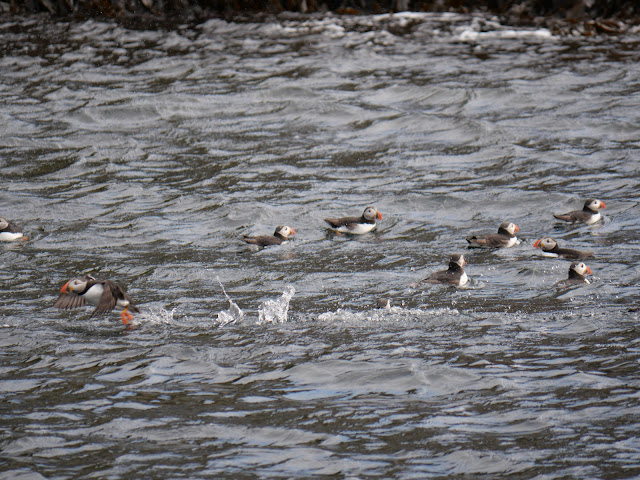Norway, puffins, Senja (part 7)
We intended to go on a whale safari. in Andenes. Unfortunately, due to the wind and rough sea, the trips for the next day were cancelled. We slept near the town Bleik and waited. Next day, for the same reason, all trips for the next three days were cancelled, and we were invited to come back next year. Instead of going on a whale safari, in the afternoon we went by boat to a nearby island Bleiksoya and learned lots about puffins. Puffins are used to living in extreme weather conditions, as they spend as much as eight months at sea. They return to the Bleiksoya bird rock in the summer when they have babies. Each pair of puffins has only one egg per season. They take care of the babies for about six weeks. After leaving the nest, they are immediately completely independent and cannot count on free meals from their parents. They spend the next few years at sea and return to the island as adults. They can dive as far as nearly hundred metres to catch fish, and can easily carry many fish in the beak at the same time. One of the dangers that lurks on the puffins is the sea eagle, which we also saw during our boat trip. Not to disturb the bird, it is prohibited to visit the island during the summer until the first of October.
Popoldne sva hitela proti severu v Andenes, kjer sva želela oditi na ogled kitov z barko. Prijazna uslužbenka nama je pojasnila, da zaradi vetra in razburkanega morja izleti za naslednji dan odpadejo. Prespala sva v bližini bližnjega kraja Bleik in čakala na naslednji dan. Tokrat so iz istega vzroka odpovedali vse izlete za naslednje tri dni in naju povabili, da se vrneva naslednje leto. Namesto opazovanja kitov sva šla popoldne z ladjico do bližnjega otoka, kjer je ogromno njork in o njih marsikaj izvedela. Njorke so zelo trdoživi ptički, saj kar osem mesecev preživijo na odprtem morju. Na otoček Bleiksoya se vračajo poleti, ko imajo mladiče. Vsak par njork ima le enega mladiča na leto. Starši zanj skrbijo približno šest tednov. Prehranjujejo se z majhnimi ribami, ki jih lovijo za svoje mladiče. Zanje skrbijo okoli šest tednov. Ko mladiči zapustijo gnezdo, so popolnoma samostojni in se ne morejo več zanašati na pomoč staršev. Naslednjih nekaj let preživijo na morju in se na otok vrnejo kot odrasli. Lahko se potopijo skoraj do sto metrov, ko lovijo ribe. S kljunom pa lahko naenkrat ulovijo več ribic. Ena od nevarnosti, ki preži na njorke je morski orel, tega smo ga videli tudi med našim izletom. Vstop na otok je med poletjem do 1. oktobra prepovedan, da ne bi motili ptic.
After the trip, we managed to go on the ferry to Senja. The sea was quite rough and we were feeling a little sick. We continued our journey along Senja, but the weather got worse. The Devil's teeth mountain range was hidden behind the fog. We spent the night near the village of Ersfjord, where we first met a family from Slovenia. Before going to sleep, we exchanged some traveling adventures and experiences.
Po izletu sva ulovila trajekt za Senjo. Morje je bilo precej valovito, vožnja pa kar naporna, malo nama je bilo slabo. Nadaljevala sva pot po Senji, vreme pa se je nekoliko pokvarilo. Gorovje Devil's teeth (Hudičevi zobje) je bilo ovito v meglo. Prespala sva v bližini vasice Ersfjord, kjer sva prvič srečala družino iz Slovenije, ki je bila na potovanju po Norveški. Pred spanjem smo si izmenjali nekaj dogodivščin in nasvetov s poti.
The next morning it was cloudy and foggy. First, we decided to climb Husfjellet. The starting point is near the camp (69.443901, 17.297001). After a little less than an hour's walk to Sommersdalen (half a way), we realized that the top of the hill was covered in fog. We continued part of the way, but there was no point in persisting to the top, as we were literally walking through the fog and could barely see a few steps in front of us. So we returned to Sommerdalen and enjoyed the views.
Naslednje jutro je bilo še veliko bolj oblačno in megleno. Najprej sva se odločila za vzpon Husfjellet. Izhodišče je v bližini kampa (69.443901, 17.297001). Ko sva prišla po malo manj kot uri hoje do Sommersdalen, sva ugotovila, da je vrh prekrit z meglo. Nadaljevala sva še del poti, vztrajanje do vrha pa ni imelo smisla, saj sva dobesedno hodila skozi meglo in komaj videla par korakov pred sabo. Zato sva se vrnila na Sommerdalen in užival v razgledih.
In the afternoon, we planned to climb to hill Hesten, from where there are wonderful views of neighboring mountain Segla and the surrounding area. At the starting point, we quickly realized that the hills are also covered in fog and we cannot expect any views. Our assumption was also confirmed by hikers returning to the valley. Here, the weather is unpredictable and slowly we were getting used to it.
Popoldne sva se nameravala povzpeti na Hesten, od koder so čudoviti razgledi na sosednjo Seglo in okolico. Na izhodišču sva hitro ugotovila, da so hribi tudi tu pokriti z meglenim pokrovom in nekih posebnih razgledov ni pričakovati. To so potrdili tudi pohodniki, ki so se vračali v dolino. V teh krajih je treba pričakovati, da lahko vreme tudi ponagaja in počasi sva se sprijaznila tudi z tem.
.JPG)

.JPG)
.JPG)
.JPG)

.jpg)
.JPG)

.JPG)



Puffins in Newfoundland are such a treat to see as well. Love those goofy looking birds! Incredible scenery!
ReplyDeleteThanks for all the facts about the puffins. An impressive sight of them all. I wonder will you return next year to see the whales?
ReplyDeleteI would love to, but it's a very long way from here.
ReplyDelete